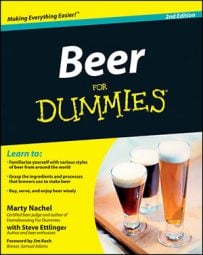Beer aromas are fleeting, so start with a sniff even before you take a look. Also, flavor is partly based on aroma — a full 1/4 to 1/3 of your ability to taste is directly related to smell, so don’t underestimate the role your nose plays in your beer enjoyment.
Like wine and whisky critics, beer evaluators use the term nose in two ways: to describe aroma and bouquet (if aroma were a sound, bouquet would be the volume) as well as the act of takin in a beer's aroma. You may say, for example, “While nosing his Porter, he commented on its robust licorice nose.”
The most prominent aromas associated with beer’s nose usually come first from malt and second from hops:
Malt: Malty aromas can run from perfumy-sweet to rich and caramel-like and are fairly obvious. Depending on how dark the beer is, roasty, toasty, or chocolaty aromas may come from the specialty grains added to the beer.
Hops: This aroma depends on the variety and amount of hops added to the boiling beer during the brewing process and on whether aromatic hops were added to the beer during the fermentation or aging phases. Hop aromas may be described as herbal, perfumy, spicy, grassy, earthy, floral, piney, citrusy, and occasionally cheesy (and Sleepy, Sneezy, Dopey, Grumpy, and Bashful, too, no?).
Other aromas, such as fruity esters and alcohol aromas, are created during fermentation and are referred to as fermentation characteristics. Some ales have a buttery or butterscotch smell (diacetyl) that’s the result of warm fermentations and certain yeast strains. If you smell or taste creamed corn in your lager, it may be something called DMS (di-methyl sulfide). Plastic, cooked vegetable, rotten eggs, skunky (catty), and wet dog smells are common signs of — guess what — badly made or stored beer.

